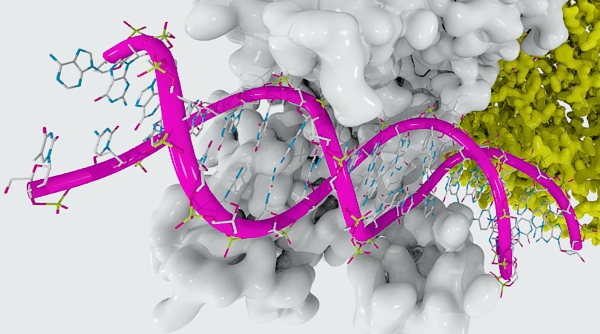DNA sun protection

Nature has developed clever mechanisms to protect our DNA from damaging radiation. Photo: Enzymlogic, Licence: CC-BY-SA 2.0
UV radiation often damages our DNA. Researchers at Kiel University and The University of Bristol, Great Britain, have now seen for the first time what happens in DNA building blocks when they are stimulated by ultraviolet light, and what they do to prevent themselves from being destroyed.
The results show: the molecules use the absorbed energy to set off a completely harmless reaction which prevents the genes being altered. The study can be found in the current edition of the journal Angewandte Chemie (Applied Chemistry).
Our DNA contains the bases adenine, guanine, cytosine and thymine. The chemists used ultra short blasts of light to shoot base pairs guanine and cytosine which were stimulated with UV light. They were only able to reveal the protective molecular mechanism using this method of femtosecond spectroscopy, because the process happened within a few quadrillionths of a second.
During the so-called electron-driven proton transfer process (EDPT), a hydrogen atom is displaced within the molecular compound. The base pair, however, immediately returns to its original starting structure from the same procedure. “Nature uses the reaction to strengthen the DNA's resistance to light by orders of magnitude – it is sort of a sun protection for DNA”, said Professor Friedrich Temps, head of the Kiel research team from the Institute of Physical Chemistry.
“The DNA building blocks themselves thereby relieve the cells' hugely complex and very slowly active repair mechanisms using enzymes. The discovery of these enzymes this year was awarded the Nobel Prize for Chemistry. Without the passive processes we observed, the cells' active repair mechanisms would be completely overloaded”, added Professor Andrew Orr-Ewing, head of the team in Bristol.
In a few cases, however, the base pair was not able to return to the original situation. Here, EDPT caused two hydrogen atoms to be displaced. “The product could be a mutagen precursor and lead to DNA damage”, explained Dr Katharina Röttger from the English working group, who received her doctoral degree in Kiel. Future experiments will have to show what then happens to this molecule. “We can only say that the potentially mutagen molecule survived our measurement time frame of one nanosecond (= a billionth of a second)”, said Röttger.
The scientists now want to find out whether the same processes also occur in a long DNA strand. The many interactions within and between the molecules and in the hydrogen bridges make this undertaking more complicated, however. Extremely fast reactions are often covered up by slower ones. Professor Temps and Professor Orr-Ewing are confident that the analysis tools of their working groups will soon be able to solve this puzzle, too.
Original publication
K. Röttger, H. J. B. Marroux, M. P. Grubb, P. M. Coulter, H. Böhnke, A. S. Henderson, M. C. Galan, F. Temps, A. J. Orr-Ewing, G. M. Roberts, “Ultraviolet Absorption Induces Hydrogen-Atom Transfer in G∙C Watson-Crick DNA Base Pairs in Solution”, Angew. Chem. Int. Ed. 54, (2015). DOI: 10.1002/anie.201506940
Link: http://onlinelibrary.wiley.com/doi/10.1002/anie.201506940/abstract
Photos are available to download:
http://www.uni-kiel.de/download/pm/2015/2015-368-1.png
Caption: Katharina Röttger, Faculty prize winner for 2014 at Kiel University, investigated a chemical process in DNA base pairs, together with colleagues, using extremely short pulses of light.
Photo/Copyright: Jürgen Haacks, Kiel University
http://www.uni-kiel.de/download/pm/2015/2015-368-2.jpg
Caption: Friedrich Temps is developing methods in Kiel which can be used to observe ultra fast chemical processes.
Photo/Copyright: Denis Schimmelpfennig, Kiel University
http://www.uni-kiel.de/download/pm/2015/2015-368-3.jpg
Caption: The study from Kiel and Bristol will adorn the inside cover of Angewandte Chemie. It shows the process that was investigated on how DNA protects itself from ultraviolet radiation.
Figure/Copyright: Angewandte Chemie, John Wiley & Sons
Further information:
http://www.temps.phc.uni-kiel.de/en
The study was carried out within the Collaborative Research Centre 677 “Function by Switching”, where scientists investigate and create molecular switching processes: www.sfb677.uni-kiel.de.
Details, which are only a millionth of a millimetre in size: This is what the research focus “Kiel Nano, Surface and Interface Science – KiNSIS” at Kiel University has been working on. In the nano-cosmos, different laws prevail than in the macroscopic world – those of quantum physics. Through intensive, interdisciplinary cooperation between materials science, chemistry, physics, biology, electrical engineering, computer science, food technology and various branches of medicine, the research focus aims to understand the systems in this dimension and to implement the findings in an application-oriented manner. Molecular machines, innovative sensors, bionic materials, quantum computers, advanced therapies and much more could be the result. More information at www.kinsis.uni-kiel.de
Contact:
Professor Dr Friedrich Temps
The Institute of Physical Chemistry
Tel.: +49 (0)431 880 7800
E-mail: temps@phc.uni-kiel.de
Media Contact
All latest news from the category: Life Sciences and Chemistry
Articles and reports from the Life Sciences and chemistry area deal with applied and basic research into modern biology, chemistry and human medicine.
Valuable information can be found on a range of life sciences fields including bacteriology, biochemistry, bionics, bioinformatics, biophysics, biotechnology, genetics, geobotany, human biology, marine biology, microbiology, molecular biology, cellular biology, zoology, bioinorganic chemistry, microchemistry and environmental chemistry.
Newest articles

“Nanostitches” enable lighter and tougher composite materials
In research that may lead to next-generation airplanes and spacecraft, MIT engineers used carbon nanotubes to prevent cracking in multilayered composites. To save on fuel and reduce aircraft emissions, engineers…

Trash to treasure
Researchers turn metal waste into catalyst for hydrogen. Scientists have found a way to transform metal waste into a highly efficient catalyst to make hydrogen from water, a discovery that…

Real-time detection of infectious disease viruses
… by searching for molecular fingerprinting. A research team consisting of Professor Kyoung-Duck Park and Taeyoung Moon and Huitae Joo, PhD candidates, from the Department of Physics at Pohang University…





















